Dive deep into Bitcoin’s August performance. This report explores the impact of macroeconomic factors, on-chain metrics, miner challenges, and the latest developments in the Bitcoin ecosystem.
Key takeaways:
- Bitcoin’s price experienced volatility in August, with a monthly decline of 8.6%.
- The total number of transactions and active wallets decreased slightly compared to July. However, Bitcoin continued to attract new users. In August, 9.43 million new addresses were added to the network, an increase of 4.5% compared to July.
- Bitcoin reserves on centralized exchanges steadily declined, suggesting traders are holding onto their BTC rather than selling. As of Aug. 31, exchanges held approximately 2.62 million Bitcoin, a 12% decrease from Jan. 1.
- U.S. spot Bitcoin ETFs experienced a slowdown in net inflows during August. While the month started with a modest outflow, inflows picked up but reversed sharply in late August and early September, with significant outflows totaling $983.31 million.
- Miner revenue plummeted to $827.56 million in August, down from $927.35 million in July. This decline was primarily due to reduced block rewards and increased mining difficulty.
- Bitcoin NFT sales volume dropped by 22% in August compared to July. Similarly, the number of transactions and participants in buying and selling Bitcoin NFTs also decreased.
Table of Contents
- In This Article
- Bitcoin ETFs Face Headwinds
- Crypto ETFs Dominate 2024 ETF Launches
- Hong Kong Bitcoin ETFs Surpass $250 Million in AUM
- Nasdaq Aims to Launch Bitcoin Index Options
- SEC Delays Decision on Carbon-Offset Bitcoin ETF
- Bitwise Bitcoin ETF Acquires Osprey Bitcoin Trust
- Bitcoin Miners Face Economic Hardships
- Bitcoin Miners See Worst Revenues
- Mining Industry Adapts to Challenges
- TeraWulf to Launch New Bitcoin Mining Facility
- Bitfarms Expands Operations with New Data Center and Acquisition
- Riot Platforms Increases Stake in Bitfarms
- Rhodium Enterprises Files for Bankruptcy
- Bitcoin Ecosystem Booms, Adoption Takes Off
- 21.co Launches Bitcoin Wrapper on Ethereum
- El Salvador to Train 80,000 Government Employees in Bitcoin
- Xapo Bank Expands into the UK with Bitcoin Services
- Banking Giants Embrace Bitcoin
- Binance Labs and Tim Draper Back New Bitcoin Token
- Babylon Bitcoin Staking Mainnet Launches
- SatLayer Raises $8 Million in Pre-Seed Funding
- Runes Transactions Slip as Bitcoin Dominance Grows
What Is Bitcoin? Bitcoin Price Slumps 8.6% in August Bitcoin On-Chain Activity Presents a Mixed Bag
Bitcoin's NFTs See Overall Decline A Month of Mixed Signals and Looming Decisions
- In This Article
- What Is Bitcoin?
- Bitcoin Price Slumps 8.6% in August
- Bitcoin On-Chain Activity Presents a Mixed Bag
- Bitcoin ETFs Face Headwinds
- Crypto ETFs Dominate 2024 ETF Launches
- Hong Kong Bitcoin ETFs Surpass $250 Million in AUM
- Nasdaq Aims to Launch Bitcoin Index Options
- SEC Delays Decision on Carbon-Offset Bitcoin ETF
- Bitwise Bitcoin ETF Acquires Osprey Bitcoin Trust
- Bitcoin Miners Face Economic Hardships
- Bitcoin Miners See Worst Revenues
- Mining Industry Adapts to Challenges
- TeraWulf to Launch New Bitcoin Mining Facility
- Bitfarms Expands Operations with New Data Center and Acquisition
- Riot Platforms Increases Stake in Bitfarms
- Rhodium Enterprises Files for Bankruptcy
- Bitcoin Ecosystem Booms, Adoption Takes Off
- 21.co Launches Bitcoin Wrapper on Ethereum
- El Salvador to Train 80,000 Government Employees in Bitcoin
- Xapo Bank Expands into the UK with Bitcoin Services
- Banking Giants Embrace Bitcoin
- Binance Labs and Tim Draper Back New Bitcoin Token
- Babylon Bitcoin Staking Mainnet Launches
- SatLayer Raises $8 Million in Pre-Seed Funding
- Runes Transactions Slip as Bitcoin Dominance Grows
- Bitcoin's NFTs See Overall Decline
- A Month of Mixed Signals and Looming Decisions
Show Full Guide
What Is Bitcoin?
Bitcoin (BTC) is a decentralized cryptocurrency created to function as a digital currency and means of payment that operates independently of any single individual, organization, or authority, eliminating the need for third-party intermediaries in financial transactions. It is allocated to blockchain miners to validate transactions and can be purchased through various exchanges.
Unveiled to the public in 2009 by an enigmatic developer or group known as Satoshi Nakamoto, Bitcoin has become the most widely recognized cryptocurrency in the world. Its success has spurred the creation of numerous other cryptocurrencies.
Bitcoin Price Slumps 8.6% in August
Bitcoin (BTC) price showed volatility in August 2024. The month began with a price of $65,264 on Aug. 1, but quickly dipped to $51,329 by Aug. 5, representing a decline of 21% in five days. This downward trend reversed, with the price climbing back up to $64,387 on Aug. 23. However, BTC’s price closed out the month at $59,845, which represents a 8.6% month-over-month drop.
Bitcoin’s downtrend prompted analysts at 10x Research to forecast a potential drop to the low $50,000 range. According to Markus Thielen, an analyst at the firm, the cryptocurrency’s price has broken below the ascending trendline of an asymmetrical triangle, suggesting a retest of the Aug. 5 low. This breakdown could lead to a price drop below $50,000.
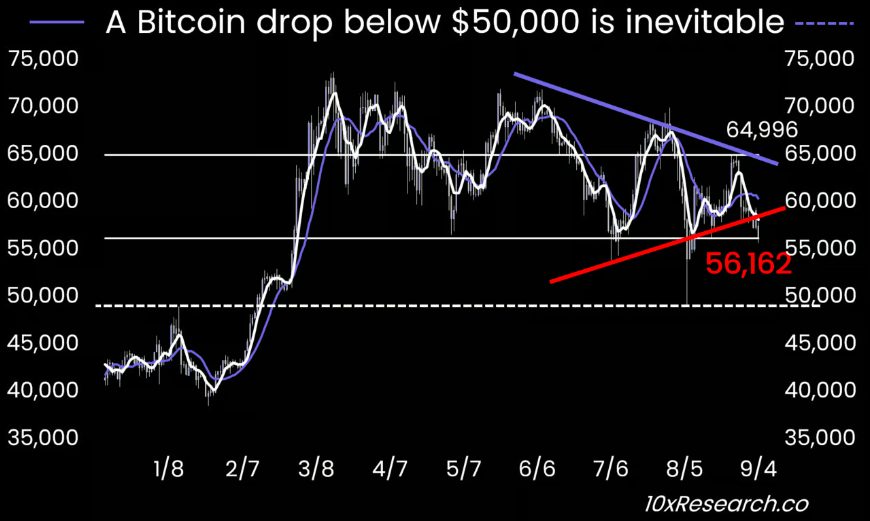
Additionally, miner behavior played a significant role in market sentiment. Glassnode data revealed that miners have been accumulating Bitcoin since Aug. 15, indicating confidence in the long-term value of the cryptocurrency. However, with the price lingering below $60,000, there is a rising concern that miners might be compelled to sell to offset operational costs. This potential sell pressure is fueling a bearish outlook for Bitcoin.
Bitcoin’s August performance was also influenced by a combination of macroeconomic factors. Trader DamiDefi noted on X that the U.S. recession narrative has stabilized, shifting the focus to monetary policy and the strength of the U.S. dollar. A bullish outlook for Bitcoin hinges on expectations of looser Federal Reserve policy, such as lower interest rates. Traders anticipate that the U.S. may be forced to implement expansionary measures to stimulate the economy.
Investors also piled into U.S. government bonds as a safe haven, with the 2-year Treasury yield falling. This reflects concerns about the labor market, with the unemployment rate rising to 4.3% in July and 4.2% in August. While inflation has eased, the risk of further job losses may limit the potential for a major rate cut.
The bottom of #Bitcoin may be in
There's a new bullish narrative for Bitcoin driven by looser Federal Reserve policy and global macro trends.
After a bearish phase in early August, expectations of the Fed easing monetary policy, such as lowering interest rates, have boosted… pic.twitter.com/PpE9dOOnwx
— Dami-Defi (@DamiDefi) September 3, 2024
Another factor contributing to the weak performance of Bitcoin in August and early September was the continued outflows from spot Bitcoin exchange-traded funds (ETFs). Bitcoin ETFs struggled to attract significant inflows last month, drawing negative attention and raising doubts about their investment appeal.
Bitcoin’s open interest (OI), a measure of the total value of outstanding derivative contracts, experienced a notable decline in August, as per data from Coinglass. OI stood at $35.11 billion on Aug. 1, but fell to $30.17 billion on Sept. 1, a decrease of 14%.

Declining OI during a period of sideways price movement often indicates that more short positions are being opened. This bearish sentiment was further supported by several days of negative funding rates in August.
Bitcoin On-Chain Activity Presents a Mixed Bag
Bitcoin’s on-chain metrics in August 2024 presented a mixed picture. While the network saw a surge in new addresses and a record-breaking daily transaction volume, the overall number of transactions and active wallets declined slightly compared to the previous month.
On-chain volume experienced a minor dip, dropping from $1.45 trillion in July to $1.44 trillion in August, a 0.7% decrease. This slight decline could be attributed to various factors, such as fluctuations in Bitcoin’s price or changes in user activity.
Transaction volume on the Bitcoin network reached a new peak in August. After a sharp 33% drop in the number of transactions, from over 711k on July 25 to 475k on Aug. 9 (based on the 7-day moving average), the volume rebounded significantly, hitting a record high of 731k on Aug. 26. Despite this surge, the total number of transactions for the month fell by 5%, decreasing from 19.51 million in July to 18.55 million in August.
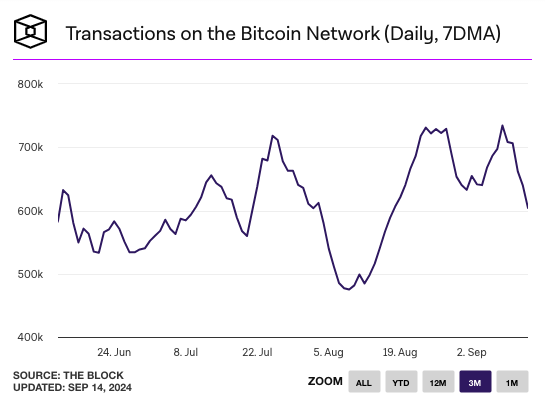
Active wallet usage also experienced a surge in early August, peaking at 751k on Aug. 6 (based on the 7-day moving average). However, this growth began to wane as the month progressed, with the count declining to 673k on Aug. 26. The total number of active wallets decreased 3% from July to 21.8 million wallets in August.
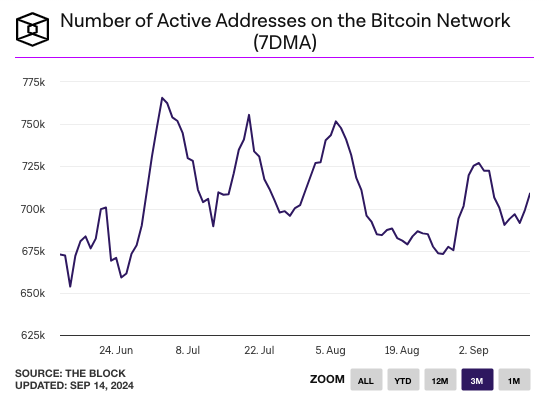
When analyzing Bitcoin’s on-chain metrics over a longer period, it becomes clear that network activity has significantly decreased in recent months, mirroring the sideways price action.
CryptoQuant’s data shows a drop in daily active addresses, indicating less overall network usage. At its peak in mid-March, coinciding with Bitcoin’s recent all-time high, daily active addresses (on average) hovered around 1.2 million. Since then, this number has shrunk to a recent low of 673k in late August, which is the lowest number of daily active addresses since 2021.
This decline in active addresses reflects less overall interest in using the Bitcoin network, which translates into fewer transactions taking place, possibly due to the extended period of stagnant price action.
However, Bitcoin’s ability to attract new addresses remained strong. In August, 9.43 million new addresses were added to the network, an increase of 4.5% compared to July.
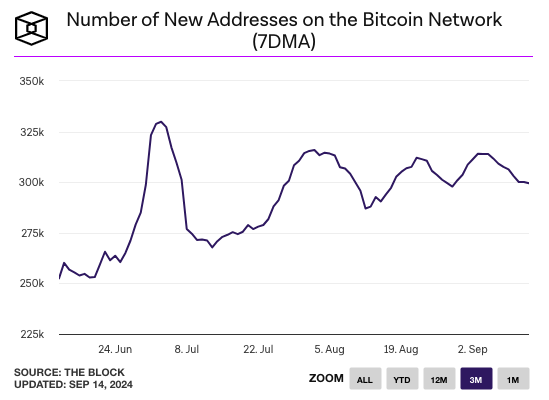
According to a Santiment X post, the number of Bitcoin wallets holding at least 100 BTC hit a 17-month high in August, surpassing 283 wallets. This increased whale activity could be a positive sign for the market, as significant whale buying has often preceded new all-time highs for Bitcoin.
As crypto prices have let retail traders down, Bitcoin whales are growing in number. A net gain of +283 wallets holding at least 100 BTC has emerged in just 1 month. The now 16,120 such wallets on the network has broken a 17-month high. pic.twitter.com/DcAU0W01Pk
— Santiment (@santimentfeed) August 31, 2024
Santiment also reported that wallets holding at least 10 Bitcoin (“sharks”) have been actively accumulating coins as well.
Another positive sign is the steadily declining supply of Bitcoin reserves on centralized exchanges, suggesting that traders are increasingly holding onto their BTCs rather than selling them.
As of Aug. 31, centralized crypto exchanges held approximately 2.62 million Bitcoin, a significant 12% decrease from the 3.01 million Bitcoin held on Jan. 1, per data from CryptoQuant. In September, Bitcoin reserves are continuing to decline, hitting an annual low of 2.57 million on Sept. 15.
These numbers suggest that traders are either moving their Bitcoin to cold storage or using it for other purposes, such as staking or decentralized finance (DeFi) applications.
If this trend continues and demand for Bitcoin remains strong, the cryptocurrency could be poised for further price increases in the coming weeks.
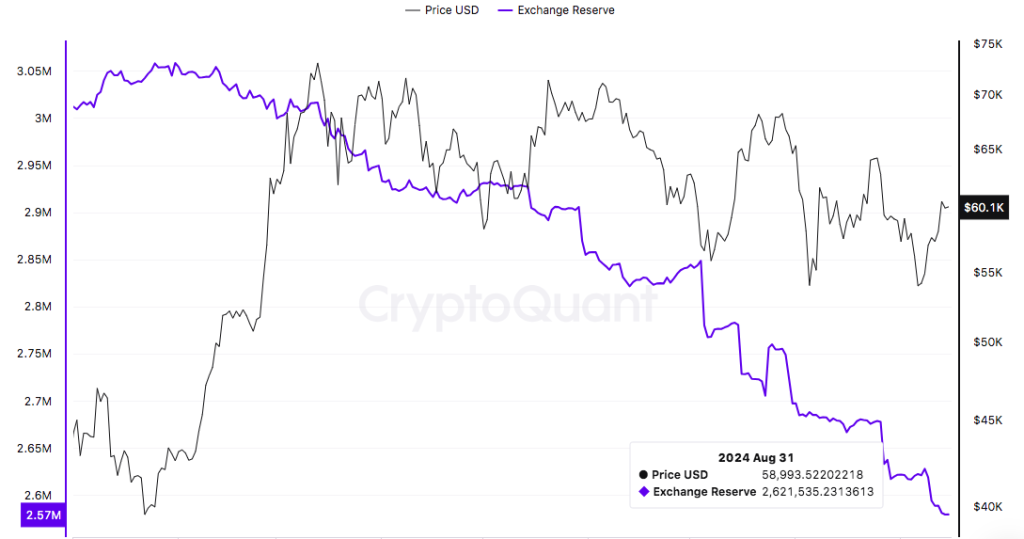
Bitcoin ETFs Face Headwinds
U.S. spot Bitcoin ETFs experienced a slowdown in net inflows during August and the early days of September. While the month started with a modest weekly outflow of $80.69 million on Aug. 2, inflows picked up in the following two weeks, reaching $32.59 million for the week of Aug. 9-16 and $506.37 million for the week of Aug. 17-23.
However, this positive momentum reversed sharply in the last days of August and the first week of September, with significant outflows totaling $983.31 million between Aug. 24 and Sept. 6.
The cumulative inflow for Bitcoin ETFs as of Sept. 13 reached $17.30 billion, according to SoSoValue data.

However, according to CryptoQuant, these inflows in August are now just a fraction of their March levels. Analysts emphasize the importance of strong institutional demand through Bitcoin ETFs to drive Bitcoin’s price to new all-time highs.
BlackRock’s iShares Bitcoin Trust (IBIT) appears to be the most successful Bitcoin ETF to date, with the highest total inflows of $20.91 billion as of Sept. 13. On Aug. 26, IBIT recorded its highest net inflow in 35 days, totaling $224.1 million on that day.
Fidelity Wise Origin Bitcoin Fund (FBTC) comes in second with $9.64 billion in inflows. ARK 21Shares Bitcoin ETF (ARKB) takes third place with total inflows of $2.356 billion.
Grayscale Bitcoin Mini Trust (BTC) has seen relatively small inflows of $380 million, while Grayscale Bitcoin Trust (GBTC) has experienced the most significant outflows, totaling -$20.04 billion.
According to K33 Research, 1,199 professional firms held investments in Bitcoin ETFs, marking an increase of 262 firms over Q2.
Institutional ownership of BTC ETFs grew solidly in Q2!
According to 13F filings, 1,199 professional firms held investments in U.S. spot ETFs as of June 30, marking an increase of 262 firms over the quarter.
While retail investors still hold the majority of the float,… pic.twitter.com/YanrZpfcCG
— Vetle Lunde (@VetleLunde) August 16, 2024
Asset managers Goldman Sachs, Capula Management and Avenir Tech emerged as the top buyers of Bitcoin ETFs in Q2 2024, according to a CoinShares Research report from Aug. 20. These three investment firms collectively purchased nearly $1.3 billion worth of BTC ETF shares.
Crypto ETFs Dominate 2024 ETF Launches
Crypto ETFs have made a significant impact on the ETF market in 2024. According to Nate Geraci, president of The ETF Store, crypto ETFs accounted for 13 of the 25 largest ETF launches of the year based on year-to-date inflows.
Of the approximately 400 new ETFs launched in 2024, the top four largest by inflows are all spot Bitcoin ETFs.
I have a very simple take on the adoption of spot btc ETFs…
Out of nearly 430 ETFs launched this yr, *all 10* new spot btc ETFs are in the top 35 (8%) by inflows.
Including the top 4 overall.
And 7 of top 20.
You simply don't put up these numbers w/out advisors allocating. pic.twitter.com/htIAtOc5Xd
— Nate Geraci (@NateGeraci) September 9, 2024
Hong Kong Bitcoin ETFs Surpass $250 Million in AUM
Spot Bitcoin ETFs in Hong Kong achieved a significant milestone in August, surpassing HK$2 billion ($256 million) in assets under management (AUM).
According to SoSo Value, Hong Kong’s Bitcoin ETFs saw total net inflows of $259.24 million, bringing their holdings to 4.47K Bitcoin. This growth in Hong Kong’s Bitcoin ETF market indicates increasing investor interest in Bitcoin and the potential for further expansion in the region.
Nasdaq Aims to Launch Bitcoin Index Options
Nasdaq, the U.S. stock exchange, announced on Aug. 27 that it plans to launch options based on a Bitcoin index to provide institutions and traders with additional tools to hedge their Bitcoin exposure.
These options would allow traders to buy or sell Bitcoin at a predetermined price on a specified date, providing a valuable tool for hedging risk and expanding purchasing power.
The proposed index options would be based on the CME CF Bitcoin Real-Time Index, which tracks Bitcoin futures and options contracts traded on the CME Group exchange.
However, this financial instrument is still subject to approval by the U.S. Securities and Exchange Commission (SEC).
SEC Delays Decision on Carbon-Offset Bitcoin ETF
The SEC postponed (once again) a decision on the listing of an ETF that combines spot Bitcoin and carbon credit futures.
Tidal Investments, the issuer of the ETF, filed the fund’s S-1 registration in December 2023, and NYSE Arca filed its initial 19b-4 filing in March.
The SEC initially delayed a decision on the ETF in May, and the deadline has now been extended to Nov. 21. If approved, the 7RCC Spot Bitcoin and Carbon Credit Futures ETF would track a portfolio consisting of 80% Bitcoin and 20% carbon credit futures.
Bitwise Bitcoin ETF Acquires Osprey Bitcoin Trust
The Bitwise Bitcoin ETF (BITB) is set to expand its assets under management by $120 million through the acquisition of the Osprey Bitcoin Trust (OBTC).
In a joint statement released on Aug. 27, Bitwise Asset Management and Osprey Funds announced an asset purchase agreement. As part of the deal, OBTC unitholders will receive shares of BITB in exchange for their OBTC shares. The transaction is expected to close later this year, subject to certain conditions.
Osprey Funds launched its OBTC on the OTC market in February 2021. The fund has been available to U.S. investors with a management fee of 0.49%.
Bitcoin Miners Face Economic Hardships
Competition and costs for miners are rising, leading to August 2024 being the worst month for miner profitability in a year. To adapt, some miners are exploring alternative revenue streams, while others are acquiring existing operations to boost their hashrate.
Bitcoin Miners See Worst Revenues
The Bitcoin network’s hashrate, a measure of its computing power, reached a new all-time high of over 742 exahashes per second (EH/s). This surge in hashrate, as recorded on Sept. 2, reflects a steady increase since 2021, primarily driven by the adoption of more powerful mining hardware like application-specific integrated circuits (ASICs).
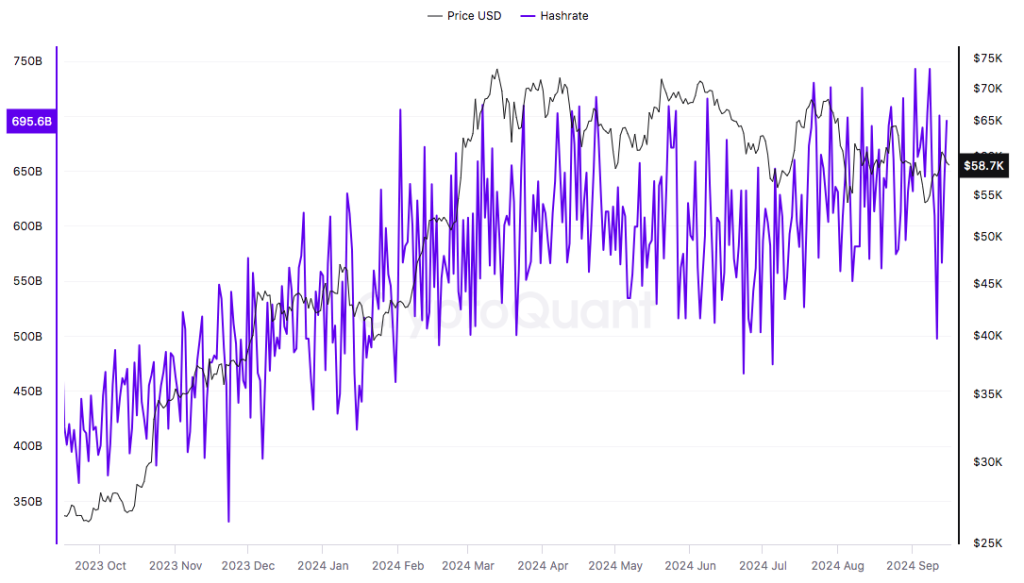
As the Bitcoin network’s hashrate increases, mining becomes more competitive and expensive. Miners are forced to invest in more powerful hardware, expand their operations, and consume more energy to maintain profitability. This rising cost has put a strain on the mining industry.
The combination of increased hashrate and high difficulty rates has directly impacted miner revenue. August 2024 was the most challenging month for miners since September 2023, with revenues plunging to a low of $827.56 million, down more than 10.5% from July’s $927.35 million.
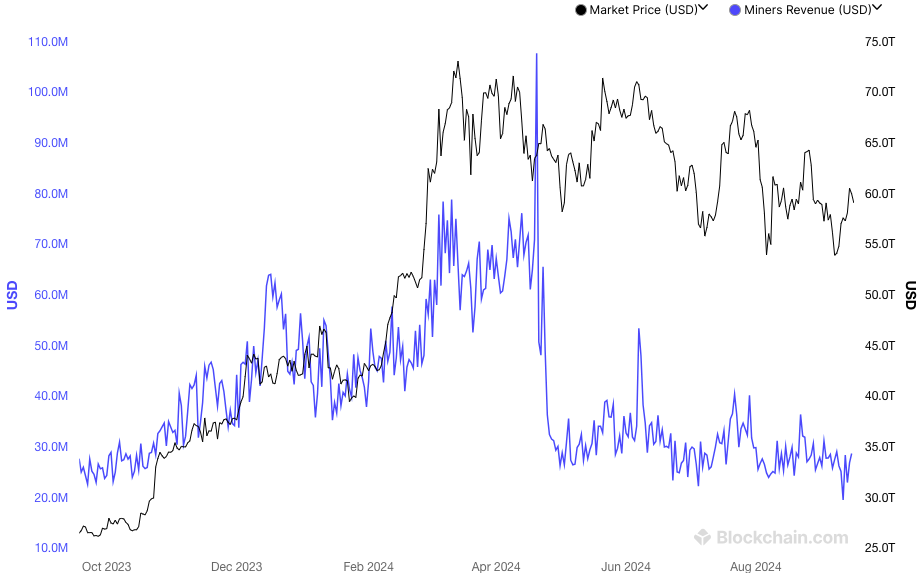
The number of Bitcoin mined in August (13,843 BTC) was slightly lower than the previous month’s total of 14,725 BTC. This decline in mining revenue was primarily driven by falling transaction volumes and a significant increase in mining difficulty following the Bitcoin halving in April. The halving event reduced block rewards by 50% to 3.125 BTC, further squeezing miner profitability.
Meanwhile, Bitcoin miners have been selling their Bitcoin holdings through exchanges, but this selling pressure started to ease in August, according to data from CryptoQuant. As miner reserves begin to stabilize, there are signs of a shift towards accumulation.

However, the low profitability of Bitcoin mining remains a concern. If miners feel compelled to sell their holdings to cover costs, it could lead to increased selling pressure and impact Bitcoin’s price.
Mining Industry Adapts to Challenges
A recent August report published by Bernstein highlighted the financial challenges facing Bitcoin miners. The report revealed that miners were facing a revenue squeeze due to multiple factors, including reduced block subsidies and increased energy costs.
To address these financial pressures, many mining companies – IREN (formerly known as Iris Energy), Hut8, Hive Digital Technologies or Core Scientific – are exploring alternative strategies and shifting focus toward the artificial intelligence (AI) and high-performance computing (HPC) data center market. According to investment firm VanEck, by utilizing their computing power and physical facilities for data processing, mining companies can generate additional revenue streams to compensate for potential shortfalls in mining profits.
“If AI/HPC comprises 20% of these miners’ energy capacity by 2027, and assuming they could fund the investment, we think the publicly traded bitcoin miners’ total additional yearly profits could exceed an average of $13.9 billion per year over 13 years.”
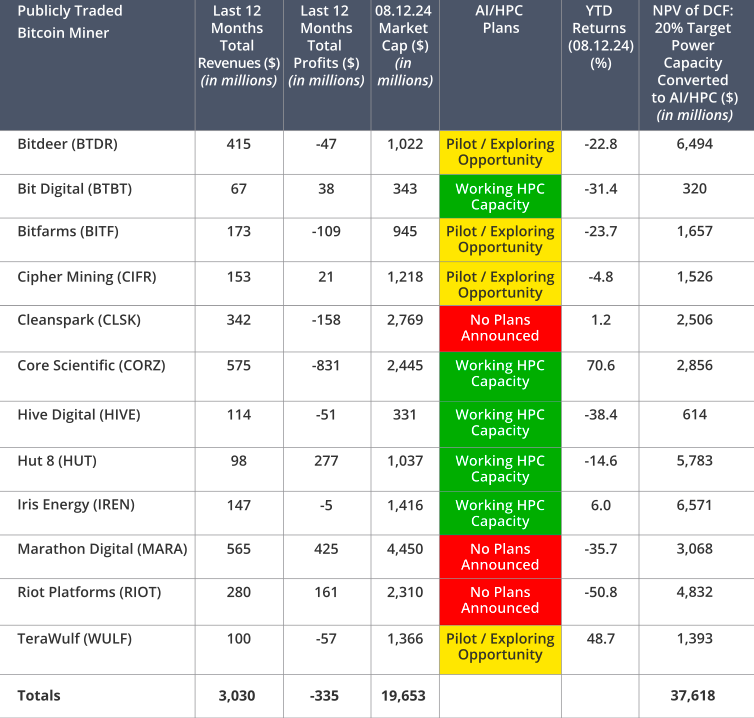
Cash-rich mining companies like Riot Platforms and Cleanspark expanded their operations by acquiring other miners with established facilities. This allows them to increase their near-term hashrate and secure additional mining capacity.
Other mining firms are exploring renewable energy sources to maintain competitiveness in the challenging mining landscape. MARA, formerly known as Marathon Digital, has been experimenting with landfill-gas-to-energy systems, which convert methane gas from landfills into usable electricity. This approach aligns with the growing trend of sustainable mining practices.
All of these strategies reflect the mining industry’s ability to adapt to new challenges in the Bitcoin mining business.
TeraWulf to Launch New Bitcoin Mining Facility
TeraWulf, the world’s sixth-largest Bitcoin mining firm, announced plans to launch a new mining facility at the end of September. Additionally, the company is exploring a potential partnership with one of the “Magnificent Seven” tech giants – Alphabet, Amazon, Apple, Meta, Microsoft, Nvidia and Tesla.
Additionally, TeraWulf plans to diversify its operations into high-performance computing and AI data centers. The company is constructing a new facility at its Lake Mariner site, allocating 2 megawatts of power for its initial foray into data center services.
TeraWulf's Strategy:
Engineering the perfect synergy between #Bitcoin mining and #AI #HPC
doing it using majorly #zerocarbon energy
doing it vertically integrated
while maximizing profits every step of the way#NotAllHashCreatedEqual #WULFDoesItBest pic.twitter.com/utXzsPjm5o
— TeraWulf (@TeraWulfInc) August 23, 2024
Bitfarms Expands Operations with New Data Center and Acquisition
On Aug. 27, Bitcoin mining company Bitfarms took ownership of its newest data center in Sharon, Pennsylvania. This marks the company’s first mega-site in the United States with access to up to 120 megawatts of power capacity.
Bitfarms has already acquired the necessary equipment and plans to bring 30 megawatts of capacity online by the end of 2024. The company is also exploring the possibility of leasing an additional 10-megawatt site, potentially expanding its total site capacity to 120 megawatts in 2025.
We are pleased to announce that Bitfarms has assumed control of its newest data center in Sharon, Pennsylvania.
– Closed on 110 MW
– 30 MW expected online by YE 2024
– LOI signed for additional 10 MWTo learn more, see the full details here: https://t.co/lLVz6XJEeA#Bitcoin… pic.twitter.com/bwmKRGSYrl
— Bitfarms (@Bitfarms_io) August 27, 2024
Additionally, on Aug. 21, Bitfarms announced the acquisition of Stronghold Digital Mining for approximately $125 million, including assumed debt of $50 million. The acquisition is expected to add up to 307 megawatts of power capacity, putting Bitfarms on track to reach over 950 megawatts by the end of 2025.
Riot Platforms Increases Stake in Bitfarms
Meanwhile, Riot Platforms, the third largest Bitcoin miner on Wall Street, continues navigating its complex relationship with Bitfarms.
In August, Riot Platforms expanded its holdings in Bitfarms. According to a regulatory filing on Aug. 13, Riot acquired an additional 1 million Bitfarms common shares, increasing its total ownership to 18.9%.
This move follows a previous attempt by Riot to acquire Bitfarms in May. Riot had offered $950 million for Bitfarms, but the proposal was rejected by the company.
Riot’s increased stake in Bitfarms could potentially influence the Canadian mining firm’s future direction and strategic decisions.
Rhodium Enterprises Files for Bankruptcy
Bitcoin mining firm Rhodium Enterprises filed for voluntary bankruptcy under Chapter 11 in the U.S. Bankruptcy Court for the Southern District of Texas. The company reported liabilities of up to $100 million in its bankruptcy filing on Aug. 24.
The filing includes six subsidiaries: Rhodium Encore, Jordan HPC, Rhodium JV, Rhodium 2.0, Rhodium 10MW, and Rhodium 30MW. The company’s estimated total assets range between $100 million and $500 million, while its debts fall within the range of $50 million to $100 million.
This bankruptcy case highlights the financial challenges facing some Bitcoin mining companies, as the industry continues to navigate a volatile market and rising operational costs.
Bitcoin Ecosystem Booms, Adoption Takes Off
The Bitcoin ecosystem continues to experience significant growth and innovation across various sectors.
21.co Launches Bitcoin Wrapper on Ethereum
21.co, the company behind cryptocurrency asset manager 21Shares, launched its own version of a wrapped Bitcoin on the Ethereum blockchain. This new token, called 21.co Wrapped Bitcoin (21BTC), was announced on Sep. 3 and joins 21.co’s existing suite of wrapped tokens for Avalanche (AVAX), Polkadot (DOT), and Solana (SOL) on Ethereum.
21.co’s launch of a Bitcoin wrapper comes at a time when the leading existing wrapper, Wrapped Bitcoin (wBTC), is facing criticism over its custodian BitGo’s proposed partnership with BiT Global. This partnership would grant the Hong Kong-based crypto exchange partial custody of the wBTC’s underlying Bitcoin holdings.
This decision sparked concerns within the community regarding the security and transparency of wBTC. With over $9.1 billion in market capitalization according to CoinMarketCap, wBTC is the most popular BTC wrapper. However, the potential involvement of a lesser-known exchange in its custody has shaken investor confidence.
El Salvador to Train 80,000 Government Employees in Bitcoin
The National Bitcoin Office (ONBTC) of El Salvador is set to provide Bitcoin training and certifications to 80,000 government employees. This initiative aims to enhance public servants’ understanding of Bitcoin and its strategic management within the country.
The 160-hour virtual training program, “Certification in Public Administration 1,” is divided into seven modules covering various aspects of Bitcoin, including laws, skills, and management practices related to its use as legal tender.
“Thousands of El Salvador’s civil servants will soon receive the highest standard of instruction on Bitcoin,” said Stacy Herbert, Director of El Salvador’s Bitcoin Office in its X post from Aug. 20. “And this will have the compounding effect of excellence begetting more excellence in El Salvador, the home of new capital markets on Bitcoin.”
El Salvador keeps winning because we keep building to the very highest standards. For three years now, the @bitcoinofficesv has been trailblazing the path upon which all other nations will follow.
Along with creating @cuboplus, building a new K-8 Bitcoin Workbook & introducing… pic.twitter.com/IzoZ1XIccW
— Stacy Herbert
(@stacyherbert) August 20, 2024
Xapo Bank Expands into the UK with Bitcoin Services
On Aug. 5, Gibraltar-based Xapo Bank launched its operations in the United Kingdom after obtaining a local banking license. The bank offers a combination of interest-bearing U.S. dollar and Bitcoin accounts, making it the first and only licensed bank in the U.K. to provide such a service.
Xapo Bank customers can now send funds up to £1.28 million ($1.28 million) to U.K.-based wallets and bank accounts. Additionally, their Bitcoin account offers a 1% interest rate without requiring any staking, lending, or asset locking.
We’re thrilled to announce the passporting of our banking license into the UK
UK authorities now recognize #XapoBank’s high standards of trust and security. With us, clients store and grow #Bitcoin with confidence. Find out more here:https://t.co/XF3hbx8Io6 pic.twitter.com/0vZayNO20D
— Xapo Bank (@xapobankapp) August 9, 2024
Banking Giants Embrace Bitcoin
Leading financial institutions are expanding their cryptocurrency services, adding Ether to their list of digital assets.
On Aug. 1, Futu Securities International, Hong Kong’s largest online brokerage, launched Bitcoin and Ether trading for its 22 million customers. The decision makes Futu Securities the first brokerage to directly offer crypto trading to Hong Kong-based retail investors.
Zurich Cantonal Bank, one of Switzerland’s largest banks, also announced on Sep. 4 that it would now provide trading and custody services for Bitcoin and Ether.
Binance Labs and Tim Draper Back New Bitcoin Token
Binance Labs and Tim Draper-backed Zest Protocol launched a new Bitcoin token called BTCz. This token enables Bitcoin holders to earn a staking yield through the Babylon Protocol.
Zest Protocol is at the forefront of a new paradigm known as Bitcoin DeFi (BTCFi) and aims to expand the utility of Bitcoin by introducing decentralized finance (DeFi) capabilities to the world’s first blockchain network.
1/ It's time to bring the best of @babylonlabs_io and @Stacks together!
Today, we're announcing Zest Protocol's first BTC yield product: BTCz
BTCz uses Babylon for yield, and Stacks for security. Read how
pic.twitter.com/ZMvpV9V2Yl
— Zest Protocol
(@ZestProtocol) September 5, 2024
Babylon Bitcoin Staking Mainnet Launches
On Aug. 22, Babylon, Bitcoin staking protocol, launched phase one of its self-custodial mainnet, allowing users to stake their BTC via smart contracts.
The platform has already attracted over 12,710 stakers who have performed more than 20,600 staking delegations.
Babylon’s launch introduces a third native use case for Bitcoin, “alongside value storage and simple payments.” By staking on Proof of Stake (PoS) networks, users can earn rewards.
REVOLUTION. IS. HERE!
Self-custodial Bitcoin staking—has finally been unlocked.
Participate in Babylon Bitcoin Staking Mainnet Phase-1: https://t.co/on18unO9iY
The Babylon Bitcoin Staking Mainnet launch leads to the third native use case for #Bitcoin, the… pic.twitter.com/onBS5ZIHKb
— Babylon (@babylonlabs_io) August 22, 2024
SatLayer Raises $8 Million in Pre-Seed Funding
SatLayer, a Bitcoin restaking platform built on the Babylon protocol, secured $8 million in a pre-seed funding round. The round was co-led by Hack VC and Castle Island Ventures.
The project initially aimed to raise $4 million but surpassed its target, attracting significant interest from various investors.
Runes Transactions Slip as Bitcoin Dominance Grows
While Bitcoin has regained its network dominance, daily Runes transactions have declined over the past two months, averaging around 50,000 per day.
After its launch in April, the Runes protocol initially led in daily transactions. However, Bitcoin has steadily gained ground and now accounts for approximately 90% of network activity. The remaining 10% is split between Ordinals, BRC-20 tokens and Runes.
In late August, Runes transactions experienced a brief spike, reaching 32% and 28% of network activity on Aug. 23 and 28, respectively. This increase was short-lived, however, as the percentage dropped back to 3% by Sept. 1.

Bitcoin’s NFTs See Overall Decline
Despite Ethereum and Solana holding the top two spots in August, Bitcoin secured third place, outperforming other contenders in NFT sales volume for the month.
However, according to CryptoSlam data, Bitcoin NFT sales experienced a decline of 22% in August compared to the previous month. While the total sales volume in August reached $60.5 million, it represents a notable decrease from July’s $77.3 million. The number of transactions also saw a slight drop, going from 119k in July to 101k in August, representing a decrease of 15%.
The number of sellers dropped from 35k in July to 29k in August, representing a 17% decline. Similarly, the number of buyers decreased from 49k in July to 38k in August, a 22% decrease, indicating that fewer users were actively engaged in buying and selling Bitcoin NFTs in August compared to the previous month.

NodeMonkes maintained its top spot in Bitcoin NFT sales for August, despite a notable decline of nearly 25% to just over $7 million. Ordinal Maxi Biz followed closely in second place, generating sales of over $6 million, a decrease of 10% from the previous month. Bitcoin Puppets secured the third position with sales exceeding $5.6 million, but experienced a more significant drop of 37%.
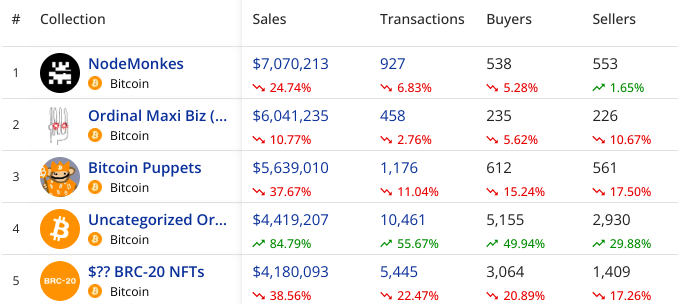
Notable NFT launches in August:
- DMT Ninja (Aug. 1 – Aug. 8): This NFT collection on Bitcoin Ordinals is renowned for its high-quality, manga-style visual design. Led by a team of talented Japanese creators with experience in Web2 gaming giants like Gree and DeNA, DMT Ninja brings a touch of Japanese art and tradition to the NFT space. Each NFT in this collection is meticulously crafted with 60 hand-drawn traits.
- NeonStacks by BlockMachine (Aug. 7 – Aug. 14): Each artwork of this NFT collection is a vibrant digital cityscape that responds to user interactions and network events. Users can nurture their NeonStacks with “Sats” to trigger special effects, customize the city’s lighting, and enjoy immersive features like fly-through tours and captivating visuals.
- CryptoAngels by Trevor Jones (Aug. 8 – Aug. 15): This NFT collection, a follow-up to the successful Archangel Collection auction, offers 7,777 NFTs on the Bitcoin Ordinals. Each CryptoAngel is meticulously designed with hundreds of variations in appearance, making them highly collectible. These NFTs are divided into “flights” aligned with specific Archangels, each with its own spiritual significance and unique shield design.
A Month of Mixed Signals and Looming Decisions
August 2024 was a complex month for Bitcoin, characterized by price volatility, on-chain activity that presented a mixed picture, and significant developments in the broader ecosystem.
While the price dipped below $60,000 and miner profitability faced challenges, positive signs emerged from ecosystem growth, institutional adoption, and innovative financial products.
The near-term price direction of Bitcoin depends on a confluence of factors. Macroeconomic factors, particularly U.S. monetary policy decisions, are likely to play a critical role. A potential pivot towards an easier monetary policy by the Federal Reserve could incentivize investors to seek riskier assets such as Bitcoin.
Despite a decline in some metrics, the continued influx of new addresses reflects continued investor interest. However, revitalized network usage is critical for a sustained price increase. The emergence of new financial products, such as BTCz and Babylon’s staking protocol could open up additional utilities for Bitcoin, potentially attracting a broader user base.
Selling pressure from miners has eased, possibly indicating a shift towards accumulation. However, the long-term viability of mining with rising costs requires close monitoring.
The slowdown in Bitcoin ETF inflows also needs to be addressed. Regulatory clarity and increased participation from large asset managers could rekindle institutional interest and push the Bitcoin price to new highs.
The post Bitcoin Price Volatility and Miner Struggles: Can a Bullish Breakout Follow? appeared first on Cryptonews.
















